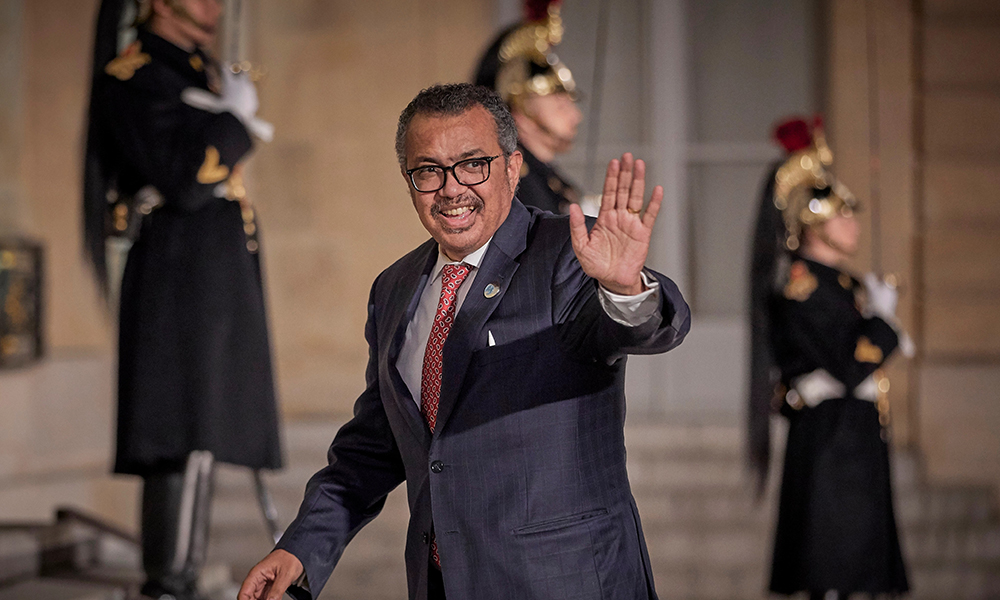
世界卫生组织(World Health Organization)的总干事谭德塞(Tedros Adhanom Ghebreyesus)在9月14日召开的新闻发布会上提到全球每日新冠死亡人数接近历史最低。他表示,我们现在“处于前所未有的有利位置来终结这场大流行”。
他说:“虽然还未走到那一步,但终点已在眼前。”
世界卫生组织的官员于9月14日表示,上周全球新增病例较前一周减少了近三分之一,共报告310万例。包括美洲、东南亚、欧洲和非洲在内的世界卫生组织划定的六个地区新增病例数均有所减少。
死亡人数也有所下降,环比减少了22%,仅报告死亡病例11,000例。
谭德塞称,上周,新冠疫情死亡人数降至自2020年3月新冠疫情刚刚爆发几个月以来的最低水平。
他表示:“我们可以看到终点线。我们将战胜疫情。但现在还不是停止奔跑的时候。”
谭德塞指出,为了结束疫情,各国政府需要进行投资,为所有高风险人群接种疫苗,包括医疗工作者和老年人,目标是全球70%的人口能够完成疫苗接种。
政府还必须继续执行新冠检测和基因测序,以控制疾病传播和变异。他还表示,各国政府应该为未来可能出现的病例激增制定计划,保障相关物资充足,并为此配备医疗人员。
谭德塞称,信息沟通将是结束疫情的关键。他鼓励各国政府创建高质量的与新冠有关的健康信息,通过数字途径进行传播,让医疗工作者做好处理虚假健康信息的准备,并向公众解释调整新冠政策的原因。
虽然上周向世界卫生组织报告的确诊人数和死亡人数下降是好消息,但世界卫生组织呼吁人们保持谨慎,因为许多国家的检测数量也处于史上最低水平,一些国家已经不再普遍开展检测。此外,可能有上周出现的确诊和死亡病例会在后期报告,这会改变疫情防控的形势。
世界卫生组织称,奥密克戎依旧是向全球共享流感数据倡议组织(GISAID)报告的主流病毒株。全球共享流感数据倡议组织是一个国际研究组织,致力于跟踪新冠病毒和流感病毒的变化。从8月12日至9月12日,全球82%至90%的病例感染的是奥密克戎BA.5变异株,BA.4和后代变异株感染病例占6%至8%。(财富中文网)
翻译:刘进龙
审校:汪皓
世界卫生组织(World Health Organization)的总干事谭德塞(Tedros Adhanom Ghebreyesus)在9月14日召开的新闻发布会上提到全球每日新冠死亡人数接近历史最低。他表示,我们现在“处于前所未有的有利位置来终结这场大流行”。
他说:“虽然还未走到那一步,但终点已在眼前。”
世界卫生组织的官员于9月14日表示,上周全球新增病例较前一周减少了近三分之一,共报告310万例。包括美洲、东南亚、欧洲和非洲在内的世界卫生组织划定的六个地区新增病例数均有所减少。
死亡人数也有所下降,环比减少了22%,仅报告死亡病例11,000例。
谭德塞称,上周,新冠疫情死亡人数降至自2020年3月新冠疫情刚刚爆发几个月以来的最低水平。
他表示:“我们可以看到终点线。我们将战胜疫情。但现在还不是停止奔跑的时候。”
谭德塞指出,为了结束疫情,各国政府需要进行投资,为所有高风险人群接种疫苗,包括医疗工作者和老年人,目标是全球70%的人口能够完成疫苗接种。
政府还必须继续执行新冠检测和基因测序,以控制疾病传播和变异。他还表示,各国政府应该为未来可能出现的病例激增制定计划,保障相关物资充足,并为此配备医疗人员。
谭德塞称,信息沟通将是结束疫情的关键。他鼓励各国政府创建高质量的与新冠有关的健康信息,通过数字途径进行传播,让医疗工作者做好处理虚假健康信息的准备,并向公众解释调整新冠政策的原因。
虽然上周向世界卫生组织报告的确诊人数和死亡人数下降是好消息,但世界卫生组织呼吁人们保持谨慎,因为许多国家的检测数量也处于史上最低水平,一些国家已经不再普遍开展检测。此外,可能有上周出现的确诊和死亡病例会在后期报告,这会改变疫情防控的形势。
世界卫生组织称,奥密克戎依旧是向全球共享流感数据倡议组织(GISAID)报告的主流病毒株。全球共享流感数据倡议组织是一个国际研究组织,致力于跟踪新冠病毒和流感病毒的变化。从8月12日至9月12日,全球82%至90%的病例感染的是奥密克戎BA.5变异株,BA.4和后代变异株感染病例占6%至8%。(财富中文网)
翻译:刘进龙
审校:汪皓
The world has “never been in a better position to end the pandemic,” Dr. Tedros Adhanom Ghebreyesus, the head of the World Health Organization, said at a September 14 press briefing, speaking on the subject of daily global deaths from COVID-19 sitting close to record lows.
“We are not there yet,” he said, “but the end is in sight.”
Worldwide, new cases of COVID-19 decreased by nearly a third last week compared to the previous week—to 3.1 million cases, WHO officials said on September 14. A decrease in cases was reported in all six WHO regions, including the Americas, Southeast Asia, Europe, and Africa.
Deaths also dropped—by 22% week over week, with just over 11,000 fatalities reported.
COVID deaths reported last week were at the lowest level the world has seen since March 2020, mere months into the pandemic, Adhanom Ghebreyesus said.
“We can see the finish line. We’re in a winning position,” he said. “But now is the worst time to stop running.”
Bringing the pandemic to a close will require governments around the world to invest in vaccinating all at-risk individuals, including health workers and the elderly, with a goal of vaccinating 70% of the global population, Adhanom Ghebreyesus said.
Governments must also continue to test for COVID and sequence samples in order to stay on top of disease spread and mutation. And they should expect further surges, and prepare supplies and health workers accordingly, he added.
Communication will play a key role in bringing the pandemic to a close, Adhanom Ghebreyesus said. He encouraged governments to develop high-quality health information about COVID that can be disseminated digitally, prepare health workers to address health misinformation, and to explain the reasons behind any COVID policy changes to the public.
While the drop in diagnoses and deaths reported to the WHO last week is promising, the organization urged caution, as testing is at all-time lows in many countries and is becoming less prevalent in others. Further, additional cases and deaths that occurred last week may be reported and added to the totals at a later date, changing the picture.
Omicron continues to dominate sequences being reported to GISAID, an international research organization that tracks changes in COVID and the flu virus, according to the WHO. Globally dominant Omicron spawn BA.5 comprised 82%–90% of cases from Aug. 12-Sept. 12, with BA.4 and descendants comprising 6%–8% of cases.






